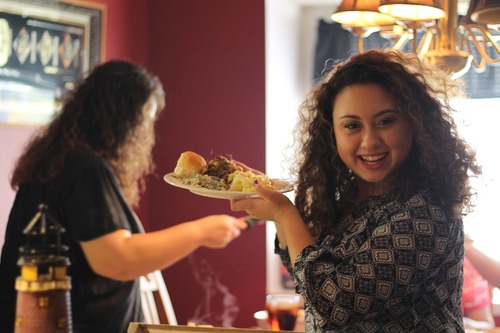Thanksgiving and The Magic of Family Meal Time
Christmas and Thanksgiving have always been my favorite times of the year: time with family and joyous celebrations. From my 20s on, I lived in California and my family was on the East Coast so I chose Christmas as the time to go East to visit, and spent Thanksgiving with friends in California.
It was always a great day, but there was one very interesting phenomenon that happened most years: everyone was very attached to having dishes from their childhood Thanksgivings. That meant we often ended up with multiple duplicate dishes, just made with different recipes.
I recall a Thanksgiving dinner for 8 that had two large turkeys, four different bowls of cranberries and an assortment of other dishes that could have fed 40. I knew at the time it was because each of us wanted to recapture the magic of our childhood Thanksgiving, but only recently did I start to give it more serious thought.
How family meal time brings out the best in us
A lot has been written in recent years about the importance of family meal times, which is near to becoming an endangered species with the proliferation of TV dinners, microwaves, over-scheduling and the need to save time.
Speeding up meals seems to have become a popular time-saving device, but one which may have backfired.
My mother followed the conventional wisdom of the 1950s and served us TV dinners –but at least we all ate them together in front of the TV!
A colleague who’s a family counselor asks new clients how often the family eats together, because that gives her the first clue as to family dynamics. It isn’t about the food [well, somewhat about the food] but more about conversation and interaction with other family members. According to WebMD.com, strong healthy families have family meals together.
What the research shows
Let’s start with the benefits. Studies by Columbia University’s National Center on Addiction and Substance Abuse [CASA] from 2009 – 2012 determined that teenagers who eat with their families at least five times a week are:
- More likely to get better grades
- Much less likely to have substance abuse problems
- Less likely to be obese
- Less subject to asthma attacks [because family meal time reduces anxiety]
- 42 percent less likely to drink alcohol
- 59 percent less likely to smoke cigarettes
- 66 percent less likely to try marijuana
I think those results definitely outweigh the convenience of McDonalds every time.
The CASA study also found that a majority of teens who ate three or fewer meals a week with their families wished they did so more often.
And a study in the Archives of Family Medicine found that when families dine together they tend to eat more vegetables and fruits and less sodas and fried foods. This is particularly important because the latest research reveals that 20% of children aged 6-19 are overweight in this country, putting them at a higher risk for high blood pressure, diabetes, and other diseases later in life.
Emotional benefits to family meal time
There are emotional benefits, too, which is what my friends and I were trying to recapture at our Thanksgivings. Family meals offer:
- Quality time with loved ones
- Increased likelihood of family support and positive adult role models
- Communication opportunities
- Language development
- An opportunity to hear stories of family history and get a sense of identity [I sure did]
- Happiness
- A well-adjusted sense of self
- Better social skills
- Problem solving opportunities
I believe that childhood bullying stems from undeveloped social skills. This is just my intuition, and I have not read any studies to back me up, but if family mealtime helps develop social skills, let’s please eat together more.
Native American teachings on family meal time
In “The Wind Is My Mother,” Bear Heart shares a story about the Pima Tribe which has what most would consider an unhealthy diet [a lot of greasy food like fry bread] but almost no heart disease. Scientists studying them could find only one reason: they were always happy and jolly while they ate.
Another indigenous view was well stated by Rutgers University anthropologist Robin Fox. He states that something precious was lost when cooking came to be cast as drudgery and meals as discretionary.
“Making food is a sacred event,” says Fox. “It’s so absolutely central–far more central than sex. You can keep a population going by having sex once a year, but you have to eat three times a day. Food comes so easily to us now that we have lost a sense of its significance. When we had to grow the corn and fight off predators, meals included a serving of gratitude. It’s like the American Indians. When they killed a deer, they said a prayer over it. That is civilization. It is an act of politeness over food. Fast food has killed this. We have reduced eating to sitting alone and shoveling it in. There is no ceremony in it.”
So let’s let every meal be an act of gratitude, community and joy. Turn off the TV, texting and let the phone go unanswered. Our lives will all be the better for it.
Molly Larkin is the co-author of the international best-seller “The Wind Is My Mother; The Life and Teachings of a Native American Shaman” and other books on health. She is passionate about helping people live life to their fullest potential through her classes, healing practice and blog at www.MollyLarkin.com


